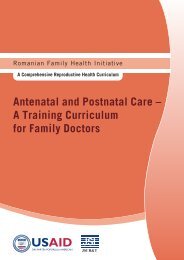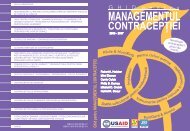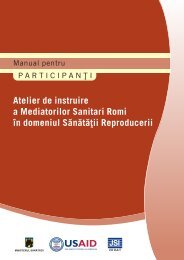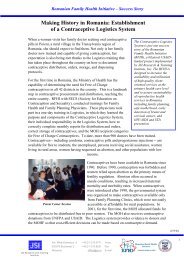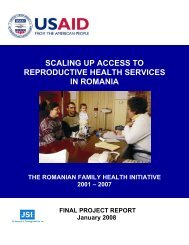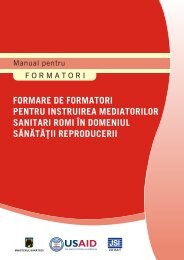Training of Roma Health Mediators in Reproductive Health
Training of Roma Health Mediators in Reproductive Health
Training of Roma Health Mediators in Reproductive Health
You also want an ePaper? Increase the reach of your titles
YUMPU automatically turns print PDFs into web optimized ePapers that Google loves.
FERTILITY AWARENESS METHODS<br />
Fertility Awareness Methods are methods that rely on various techniques to identify a<br />
woman's fertile days (the days <strong>in</strong> which she can become pregnant). In us<strong>in</strong>g these<br />
methods, a woman monitors the various changes and signs that occur <strong>in</strong> her body dur<strong>in</strong>g<br />
each menstrual cycle, which may <strong>in</strong>dicate when she is fertile and when she is not (the<br />
"safe" days to have sex). By avoid<strong>in</strong>g <strong>in</strong>tercourse on "unsafe" days, a woman may avoid<br />
pregnancy. These methods have vary<strong>in</strong>g degrees <strong>of</strong> reliability. Each method requires<br />
careful <strong>in</strong>struction and a high level <strong>of</strong> motivation and commitment on the part <strong>of</strong> the<br />
couple <strong>in</strong> order to be used successfully.<br />
Mechanism <strong>of</strong> Action<br />
The Rhythm (or Calendar) Method, one <strong>of</strong> the oldest and most widely practiced<br />
fertility awareness methods worldwide, requires the woman to calculate the fertile days<br />
<strong>of</strong> her cycle. She keeps a strict record <strong>of</strong> the length <strong>of</strong> her last six cycles (count<strong>in</strong>g the<br />
first day <strong>of</strong> bleed<strong>in</strong>g as the first day <strong>of</strong> a new cycle) and then uses a simple formula to<br />
identify her fertile days. She counts the number <strong>of</strong> days <strong>in</strong> the shortest cycle, and<br />
subtracts 18, us<strong>in</strong>g the answer to estimate the first day <strong>of</strong> fertility <strong>in</strong> a cycle. The woman<br />
then determ<strong>in</strong>es the number <strong>of</strong> days <strong>in</strong> her longest cycle, subtracts 11, and uses the<br />
answer to estimate the last day <strong>of</strong> fertility <strong>in</strong> a cycle.<br />
The Basal Body Temperature (BTT) Method requires the woman to take her own<br />
temperature every morn<strong>in</strong>g on awak<strong>in</strong>g and record it on a chart over several months to<br />
determ<strong>in</strong>e her time <strong>of</strong> ovulation. A drop <strong>in</strong> the BBT sometimes precedes ovulation by 12<br />
to 24 hours and rises immediately after ovulation, stay<strong>in</strong>g elevated slightly (0.2 to 0.5<br />
degrees C) until her next menstrual period.<br />
To use the Cervical Mucus Method (Bill<strong>in</strong>gs Method), the woman monitors and<br />
records on a daily basis the changes <strong>in</strong> her cervical mucus discharge. Typically, there is<br />
little mucus discharge for a few days follow<strong>in</strong>g menstruation. Then the mucus becomes<br />
sticky/pasty or crumbly/slightly yellow or white. As ovulation nears, the mucus becomes<br />
slippery, white, clear and wetter. Follow<strong>in</strong>g ovulation, the mucus becomes sticky/pasty<br />
aga<strong>in</strong>.<br />
The Symptothermal Method comb<strong>in</strong>es several techniques to predict ovulation. The<br />
woman monitors her cervical mucus (as <strong>in</strong> the Bill<strong>in</strong>gs Method) and her temperature<br />
changes (as <strong>in</strong> the BBT method), <strong>in</strong>clud<strong>in</strong>g other signs <strong>of</strong> ovulation, like breast<br />
tenderness, back pa<strong>in</strong>, abdom<strong>in</strong>al pa<strong>in</strong>, and light <strong>in</strong>termenstrual bleed<strong>in</strong>g. She must<br />
absta<strong>in</strong> from the first sign <strong>of</strong> wet cervical mucus until her body temperature has rema<strong>in</strong>ed<br />
elevated for three days after the peak day (the last day <strong>of</strong> clear, slippery mucus) or until<br />
the fourth day after the th<strong>in</strong> mucus is no longer observed, which ever is later.<br />
Effectiveness<br />
Fertility awareness methods have a typical pregnancy rate <strong>of</strong> about 20% <strong>in</strong> the first year.<br />
Depend<strong>in</strong>g on variables such as consistency <strong>of</strong> use, regularity <strong>of</strong> menstrual cycles, and<br />
user-related factors, consistent and correct use can reduce the pregnancy rate to 2%.<br />
When used <strong>in</strong> comb<strong>in</strong>ation with a barrier method, effectiveness is <strong>in</strong>creased.<br />
Advantages<br />
• No or low cost<br />
• No chemical products/no physical side effects<br />
57<br />
RFHI/JSI <strong>Roma</strong>nia <strong>Tra<strong>in</strong><strong>in</strong>g</strong> <strong>of</strong> RHMs <strong>in</strong> <strong>Reproductive</strong> <strong>Health</strong> Session 4: FP Methods



